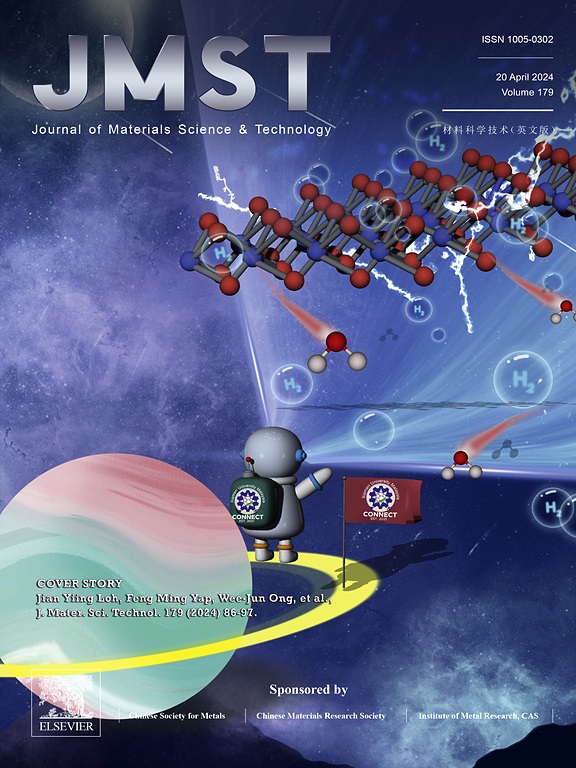BCC-HCP双相TiZrNbMoTa难熔高熵合金室温和高温磨损行为及显微组织演变
IF 14.3
1区 材料科学
Q1 MATERIALS SCIENCE, MULTIDISCIPLINARY
引用次数: 0
摘要
耐火高熵合金(RHEAs)以其优异的屈服强度和高温稳定性而闻名,但其耐磨性仍然不足。这些材料的磨损行为在很大程度上取决于它们在滑动过程中的变形机制和微观组织演变。在这项研究中,我们合成了一种超细晶TiZrNbMoTa RHEA,它具有由体心立方(BCC)和六方密堆积(HCP)相组成的双相结构。这种独特的微观结构通过在室温(RT)下原位形成梯度纳米结构层和在600℃干滑动时形成鱼鳞状非晶纳米复合氧化物层来增强耐磨性。在室温下,磨损率为1.15 × 10−4 mm3/(N m);在600℃时,磨损率为9.85 × 10−6 mm3/(N m)。在RT处,形成了厚度约为3 μm的亚表面变形层,上部1.2 μm呈现出明显的纳米层状结构,下伏晶粒沿滑动方向弯曲拉长。在600℃时,磨损表面形成一层鱼鳞状的非晶纳米复合氧化物保护层,有效地防止了合金与对体的直接接触。本研究提出了一种提高BCC-HCP双相TiZrNbMoTa RHEAs耐磨性的新方法,强调了纳米结构表面层在改善滑动条件下性能方面的关键作用。本文章由计算机程序翻译,如有差异,请以英文原文为准。

Wear behavior and microstructural evolution of a BCC-HCP dual-phase TiZrNbMoTa refractory high-entropy alloy at room and elevated temperatures
Refractory high-entropy alloys (RHEAs) are celebrated for their exceptional yield strength and high-temperature stability, yet their wear performance remains insufficient. The wear behavior of these materials is largely governed by their deformation mechanisms and microstructural evolution during sliding. In this study, we synthesized an ultrafine-grained TiZrNbMoTa RHEA featuring a dual-phase microstructure comprised of body-centered cubic (BCC) and hexagonal close-packed (HCP) phases. This unique microstructure enhances wear resistance via the in-situ formation of gradient nanostructured layers at room temperature (RT) and fish-scale-like amorphous-crystalline nanocomposite oxide layers at 600°C during dry sliding. The RHEA shows the wear rates of 1.15 × 10−4 mm3/(N m) at RT and 9.85 × 10−6 mm3/(N m) at 600°C. At RT, a subsurface deformation layer approximately 3 μm thick developed, with the upper 1.2 μm displaying distinct nanolayered structures, while the underlying grains bent and elongated along the sliding direction. At 600°C, a protective fish-scale-like amorphous-crystalline nanocomposite oxide layer formed on the worn surface, effectively preventing direct contact between the alloy and the counterbody. This study presents a novel approach to enhancing wear resistance in BCC-HCP dual-phase TiZrNbMoTa RHEAs, highlighting the critical role of nanostructured surface layers in improving performance under sliding conditions.
求助全文
通过发布文献求助,成功后即可免费获取论文全文。
去求助
来源期刊

Journal of Materials Science & Technology
工程技术-材料科学:综合
CiteScore
20.00
自引率
11.00%
发文量
995
审稿时长
13 days
期刊介绍:
Journal of Materials Science & Technology strives to promote global collaboration in the field of materials science and technology. It primarily publishes original research papers, invited review articles, letters, research notes, and summaries of scientific achievements. The journal covers a wide range of materials science and technology topics, including metallic materials, inorganic nonmetallic materials, and composite materials.
 求助内容:
求助内容: 应助结果提醒方式:
应助结果提醒方式:


